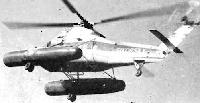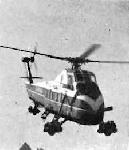Фотографии
-
Регистрационный номер: TK593 Still in R.A.F. colours is the de Havilland D.H.98 Mosquito. Illustrated is a B Mk. 35 (TK593), converted to target-towing standard and operated by Airwork Ltd. (other two are T Mk.3 (TV977) and TT Mk. 35 (RS712).) at RAF, Hornchurch, Essex, on contract for Army co-operation in connection with antiaircraft gunnery training . Note wire guards on the tail assembly.
Самолёты на фотографии: De Havilland Mosquito B / D.H.98 - Великобритания - 1940
-
Photographs of aircraft of the Portuguese Air Force rarely find their way into print, so that the markings (green and red) on this Republic F-84G Thunderjet may be unfamiliar. Maximum speed of this single-seat fighter/bomber, supplied under M.D.A.P. (N .A.T.O.), is 605 m.p.h. Power is a 5.600-lb. s.t. Allison J35-A-29 turbojet. Fin serial is 5137.
Самолёты на фотографии: Republic F-84 Thunderjet - США - 1946
-
SIKORSKY S-58. Different types of emergency flotation gear are being tried out on the twelve-passenger Sikorsky S-58 helicopter which is now in scheduled operation both in the U.S.A. and Belgium . Lightweight flotation bags and a new twin mainwheel undercarriage are being experimented with at the Sikorsky plant.
Самолёты на фотографии: Sikorsky CH-34 / S-58 Choсtaw - США - 1954
-
SIKORSKY S-58. Different types of emergency flotation gear are being tried out on the twelve-passenger Sikorsky S-58 helicopter which is now in scheduled operation both in the U.S.A. and Belgium. In Belgium, SABENA is operating its present fleet of five S-58s with Air Cruisers' (Belmar, New Jersey) collapsible, rubberised "doughnuts" which can be inflated in six seconds.
Самолёты на фотографии: Sikorsky CH-34 / S-58 Choсtaw - США - 1954
-
One of the seven French Air Force Mystere IICs which visited No. 41 Squadron. R.A.F. (Hunter Ss). at Biggin Hill in April on a N.A.T.O. exchange visit. Serial is M.D.453-65 of No. 2 Escadrille. No. 10 Wing, normally based at Criel. Note new addition of dorsal camera-gun mounting above the intake.
Самолёты на фотографии: Dassault Mystere / MD-452 - Франция - 1951
-
First three-seat Jodel, called Jodel-Robin after the Aero-Club de la Cote d'Or (Dijon) instructor/builder. Monsieur Robin's Jodel is basically a D-117.
Самолёты на фотографии: Jodel D.11 / D.112 / D.117 / D.119 - Франция - 1951
-
On their way to combat the rebels in Algeria are these two French Air Force crew trainers, temporarily fitted with rocket-launching rails under each wing. A Morane Saulnier M.S.733 Alcyon (Halcyon: mythical bird) two/three-seat basic trainer powered by a 240-h .p. Potez 6D.30 engine. Note bomb carriers, one sandwiched between each of the twin R.P. rails.
Самолёты на фотографии: Morane-Saulnier MS.733 Alcyon - Франция - 1949
-
Bearing the markings of the Spanish Air Force is this three-seat liaison Fieseler Fi 156C-1 Storch (Stork), powered by a 240-h.p. Argus As 410C. On the fin is the serial L16-9 .
Самолёты на фотографии: Fieseler Fi.156 Storch - Германия - 1936
-
Регистрационный номер: N17605 A 1938-built, four/five-seat Spartan Model 7-W Executive which has a ventrally-mounted O/F loop. N17605 has the fashionable white top-decking, plus maroon trim. It has a maximum speed of 212 m.p.h. for an a.u.w. of 4,400 lb.
Самолёты на фотографии: Spartan 7W Executive - США - 1936
-
With bomb-carriers sandwiching the twin R.P. rails, these two S.I.P.A. S.12s are derived from the German Arado Ar 396 of 1944. Power is a 580-h.p. SNECMA-Renault 12S-02 engine.
Самолёты на фотографии: SIPA S.10 / S.11 / S.111 / S.12 - Франция - 1945
-
Post-war West German two-seat design seen at Hangelar airfield, near Bonn, on 31st March , is the prototype Raab Moraa - otherwise "Motor-Raab" - built by A. Putzer of Bonn to design of Fritz Raab. Power: 32-h .p. Volkswagen engine; soon to be replaced by 65-h.p. Porsche flat-four in production models. This is a revised, powered version of the Doppel-Raab glider.
Самолёты на фотографии: Raab/Putzer Moraa - Германия - 1955
-
Регистрационный номер: D-EGOL Post-war West German two-seat design seen at Hangelar airfield, near Bonn, on 31st March , is an unidentified all-wing pusher (D-EGOL), suggesting a strong Horten influence.
Самолёты на фотографии: Horten Ho.33 - Германия - 1954
-
CIVILlANISED CADET. Originally a civil design, the two-seat Interstate Model S-1 Cadet was produced in 1940 with a 65-h.p . engine. In 1942, Interstate began delivering to the U.S. Army the first of a contract order for two hundred and fifty Model S-1B Cadets, which has increased power - 102-h.p. Franklin O-200-5 engine - and a lengthened and widened (diagonally outwards) cockpit glazing. Photographs show an ex-U.S. Army Interstate L-6 in New York State, registered N46335.
Самолёты на фотографии: Interstate S-1 Cadet / L-6 Grasshopper - США - 1940
-
Регистрационный номер: YR-RGB New Rumanian club trainer is the RG-6, a tandem two-seater in the F.A.1. Class Ie sporting category. Power is a 75-h.p. Czech Praga D flat-four engine, giving a maximum speed of 106 m.p.h. Designer is Ing. Vladimir Novichi. An improved aerobatic version, the RG-7, is under construction . Main undercarriage legs of the RG-6 retract into the wing.
Самолёты на фотографии: Novitchi RG-6 / RG-7 - Румыния - 1957
-
The IAR-813 is a side-by-side two-seater of mixed wood and metal construction powered by a 160-h.p. Waiter Minor 6-III inline. The IAR-813 has a maximum speed of 115 m.p.h. for an a.u.w . of 1,543 lb .
Самолёты на фотографии: IAR IAR-811 / IAR-813 - Румыния - 1949
-
MODE DE FRANCE. Making their debut last month were the latest mount of the famous aerobatic Patrouille de France - and replacing last year's Ouragans - recent-production Mystere IVAs (serial no. 299, illustrated) of Dijon's 2eme Escadre de Chasse. Note red, white, blue fuselage trim replacing roundels, also red, white, blue wings, upper and lower and under the tail.
Самолёты на фотографии: Dassault Mystere IV / MD-454 - Франция - 1952















